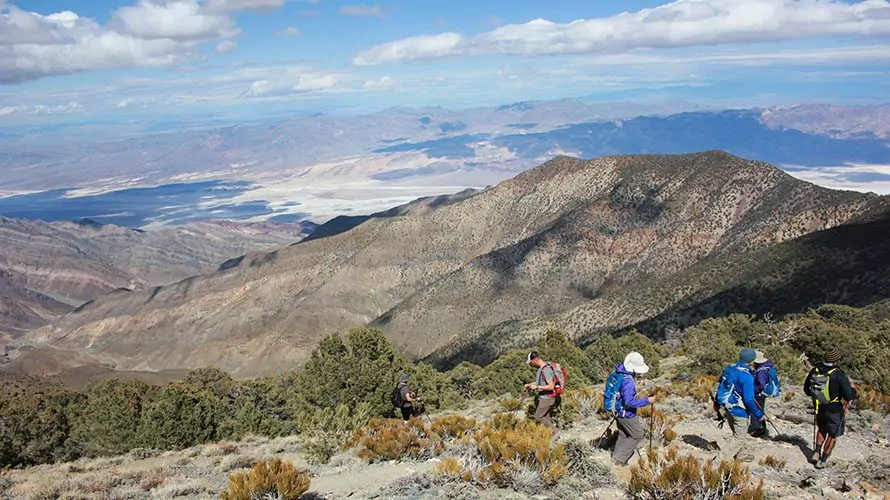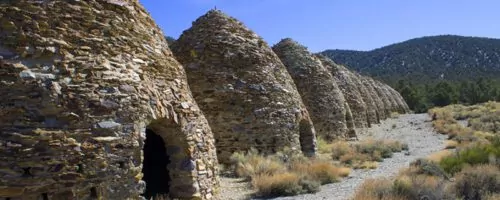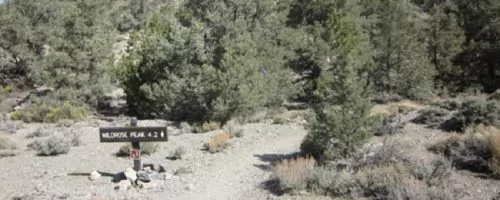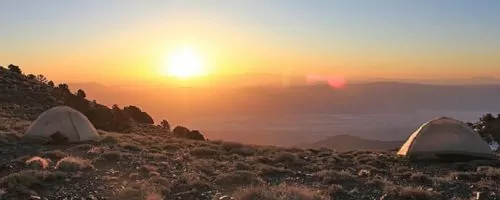
Wildrose Peak Trail
General Description
Wildrose Peak Trail is perfect for the weekend peak bagger or anyone seeking a challenging day hike. The trailhead starts at the beautifully preserved historic Charcoal Kilns. From here, hikers follow the remnants of the old logging road to a saddle to stunning views of the Badwater Basin salt flats. Take a minute to catch that second wind before the steep ascent to the summit. A series of tight switchbacks wind their way up the side of the mountain in full view of the valley floor over 8000 feet below. Enjoy a few moments of triumph at the summit just over 9000 feet above sea level. A sweeping panorama reveals Death Valley stretching east and north, Telescope and Rogers peaks towering to the south, and the mighty Sierra Nevada to the west. Write a few inspiring words in the summit register, and enjoy the views.
Explore Death Valley with Expert Guides
Getting to the Wildrose Peak Trailhead
From Furnace Creek Village take CA-190 West approximately 33.5 miles. From Panamint Springs, it is just over 21 miles East on CA-190 to a right turn on Emigrant Canyon Road. Turn left onto Emigrant Canyon Road. From the turnoff carefully drive the narrow, crooked 28 miles past the Wildrose Campground to the Charcoal Kilns. The last two miles is a rough gravel road, usually passable by a 2wd sedan. The trailhead is signed and located just north of the kilns.
History of the Charcoal Kilns
The Wildrose Charcoal kilns are ten beehive-shaped structures, each a 25′ tall standing monument to Death Valley’s mining history. The kilns were completed in 1877 by the Modock Consolidated Mining Company to provide smelting fuel for lead-silver mines 25 miles away. The thick pinyon forests were a great source of wood for charcoal production. Two years later, in 1879, operations at the kilns ceased and they were abandoned. This probably explains why they are in such pristine condition today. Interestingly, Modock Company was a venture of Mr. George Hearst, father of William Randolph Hearst, though it was certainly not one of his more profitable ventures. The remote location, primitive roads, and the resulting depletion of pine forests near the kilns were their ultimate demise.

Award Winning USA Hiking Vacations
3 Best Day Hikes Near the Wildrose Peak Trail
Wildrose Peak might make a full day for most hikers, but the fun doesn’t have to stop there. Maximize your time in Death Valley National park with these other fantastic nearby trails.
| Destination | Miles | Elev | Difficulty | Style | |
| Mesquite Flat Sand Dunes | N/A | <100 ft | Easy | Out and Back | |
| Mosaic Canyon | 3.5 mi | 1000 ft | Easy-Moderate | Out and Back | |
| Telescope Peak | 12 mi | 3300 ft | Strenuous | Out and Back |
1. Mesquite Flat Sand Dunes
The Mesquite Flats Sand Dunes are truly a sight of wonder and amazement, a trove of cinematic history, and a playground for kids and the young at heart. Located just on the outskirts of the village of Stovepipe Wells, the dunes are a great place to romp, play, and explore. Early risers witness the surrounding mountains set ablaze with the rising sun. A perch atop the tallest dune, at over 200 feet high, is a sublime place to watch the ember glow of daylight fade. Take a sled or sandboard and shred the steeper dunes by the light of the full moon. There’s almost no wrong way to experience the Mesquite Flats Sand Dunes in Death Valley National Park. There are no official trails in the dunes, so explore to your heart’s content. Let your inner child run wild and have fun in nature’s sand box.
2. Mosaic Canyon
Mosaic Canyon is an amazing hike for both first-time and long-time visitors of Death Valley National Park. A two mile drive up the gravel road on the western edge of Stovepipe Wells delivers hikers to the Mosaic Canyon Trailhead. The walls of smoothly polished marble immediately come together forming a short, stunning, tortuous narrows. Along the way, you may notice the mosaic-like breccia for which the canyon is named. Beyond these narrows, the canyon opens to a large wash, but the fun doesn’t have to end here. Several primitive trails work their way up the canyon to even more narrows, dry falls, and other fun discoveries. Mosaic Canyon is a perfect hike for families and seasoned desert hikers alike.
3. Telescope Peak
A hike to the magnificent Telescope Peak is a challenging thrill ride that is sure to get your heart pumping. The highest point in Death Valley National Park, Telescope peak stands over 11,300 feet above the valley floor just 7 miles east. You would literally have to be in an airplane to be so far above the ground! The trail begins at Mahogany Flat where hikers catch their first views back into Badwater Basin over 8000 feet below. Hike around Rogers and Bennett Peaks, taking in views of the Eastern Sierras to the west. Breathe deep and take your time up the 13 steep switchbacks to the final ridgeline to the breathtaking summit. Be sure to sign the summit register and take time to admire the stunning 360 panorama and celebrate your victory. You’ve earned it.
Maximize Your Visit to Death Valley National Park on a Hiking Tour
Guided multi-day packages allow visitors the opportunity to make the most of their time in Death Valley National Park and to do it hassle-free. Guided tours include gear (backpack, trekking poles, crampons in winter), meals, accommodations, local transportation, and a professional Death Valley hiking guide. Through their knowledge, stories, and personal passion, guides can bring a place to life in a way that’s much more difficult to do on your own. Read more about Death Valley Hiking Tours.

Join a Guided Death Valley National Park Backpacking Trip
Joining a Death Valley backpacking tour is a worry-free, adventurous way to experience Death Valley National Park. With your gear, meals, local transportation, permits, and fees taken care of for you, you can travel light and focus 100% on enjoying the hiking experience, while the guide company takes care of everything else. Also, by going with local experts you’ll enjoy a greater level of safety and gain a much better understanding of the history and ecology of this remarkable region. Read more about a guided Death Valley National Park backpacking trip.

When to Hike and Seasonal Considerations
Wildrose Peak is best hiked from Spring to early Winter. Even in the middle of summer, temperatures at Wildrose may be 30-40 degrees cooler than the valley floor. Because of it’s elevation, the peak typically gets snowed in during late winter and is usually clear by mid to late spring. The Emigrant Canyon and Wildrose roads are also subject to closure following weather events, so check conditions before you go. If there is snow and ice on the Panamint Range, crampons are highly recommended.
Necessary Permits
Day Hikes
No permits are required for day hiking in Death Valley National Park.
Backpacking Permits
Backcountry camping permits are voluntary and may be obtained at the Visitor Center or any Ranger Station. Due to the extreme environment and remoteness, it is recommended that solo hikers and backpackers provide itinerary information and emergency contacts to park personnel.
Suggested Packing List
Day Hike Packing List
- 3-4 liters of water per person
- Salty, calorie-rich snacks
- lunch
- backpack
- trekking poles
- crampons (in winter)
- wide-brimmed hat
- sunscreen, sunglasses
- cotton t-shirt (spring-fall)
- non-cotton t-shirt (winter)
- rain jacket
- warm non-cotton layer
- 1st-aid kit
Backpacking Packing List
- all items listed for day hikes PLUS
- additional water
- water filter/purification method
- multi-day backpack
- 3-season tent
- sleeping bag
- sleeping pad
- backpacking stove and fuel
- backpacking meals
- 2-3 pairs wool socks
- extra t-shirts
Please Respect Our National Parks – Leave No Trace
We strongly recommend abiding by all Leave No Trace ethics guidelines and practices so that our national parks and public lands are preserved for the enjoyment of future generations and for the people and animals who call these places home. Simple things like packing out your trash, obeying national park rules, and respecting the peace and quiet of our national park trails is a great start. If you’re going on a backpacking trip, you can read about more about the 7 Leave No Trace Principles.




